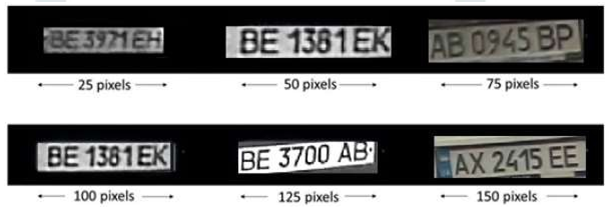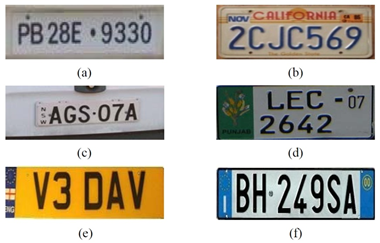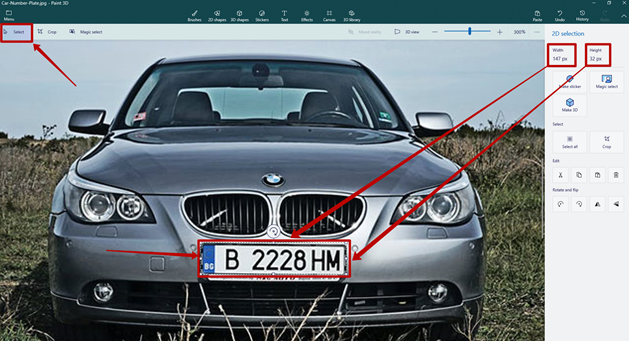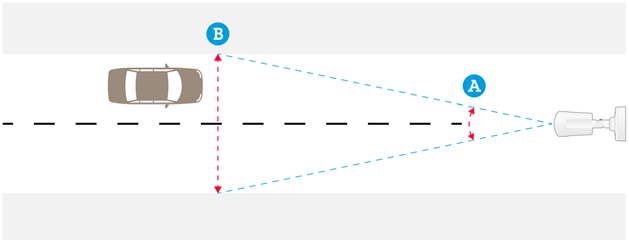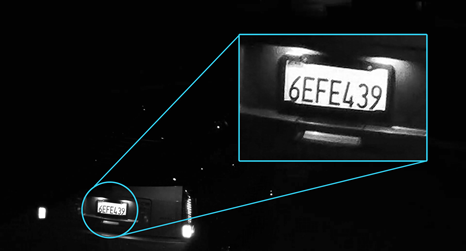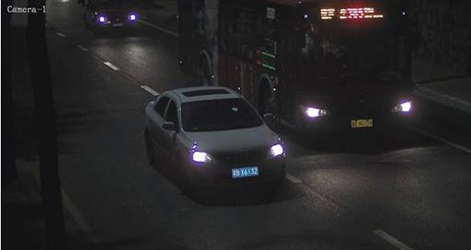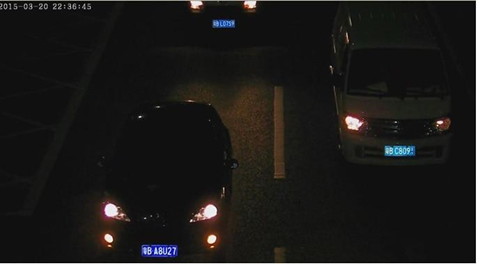General Requirements and Recommendations
Any video camera is designed for video surveillance, however, it serves various purposes. It is crucial to understand the conditions under which information will be transmitted, as well as the quality of that transmission. In this specific case, the video camera should only be focused on one task - the recognition of vehicle license plates. Therefore, when designing an LPR (License Plate Recognition) system, we recommend selecting video cameras with the following technical specifications.
Video Camera Technical Requirements
The following technical requirements are important for video cameras used in license plate recognition:
Sensitivity: Sensitivity should be at least 0.01 lux.
Matrix Size: The matrix size should be no less than 1/2 inch.
Image Resolution: 1 MP (HD 720p) resolution is recommended. Increasing the camera resolution beyond 1 MP does not improve the license plate recognition function, as it may reduce the camera's photosensitivity.
Lens Selection: Choose a lens with the highest aperture, preferably not less than F/1.4, and if possible, with a fixed focal length.
Automatic Iris Control: It is desirable to have a lens with automatic iris control, similar to the pupil of the human eye. This helps stabilize image quality when there are significant changes in illumination levels in the observed area.
- Day/Night Mode: Color cameras must have a full Day/Night mode with a removable IR cut filter.
Electronic Shutter Speed: The camera should allow setting a fixed electronic shutter speed according to the following guidelines:
1/500 sec. for speeds up to 40 km/h
1/1000 sec. for speeds up to 80 km/h
1/2000 sec. for speeds of 160 km/h and above
Refer to the table below for the recommended maximum shutter time corresponding to different camera angles and car speeds, using 1 ms (1/1000 s) as the unit of measurement:
Camera Angle | 30 km/h (⁓ 19 mph) | 50 km/h (⁓ 31 mph) | 80 km/h (⁓ 50 mph) | 110 km/h (⁓ 68 mph) | 130 km/h (⁓ 81 mph) |
|---|---|---|---|---|---|
5⁰ | 19.3 ms | 11.6 ms | 7.2 ms | 5.3 ms | 4.5 ms |
10⁰ | 9.7 ms | 5.8 ms | 3.6 ms | 2.6 ms | 2.2 ms |
15⁰ | 6.5 ms | 3.9 ms | 2.4 ms | 1.8 ms | 1.5 ms |
20⁰ | 4.9 ms | 2.9 ms | 1.8 ms | 1.3 ms | 1.1 ms |
25⁰ | 4.0 ms | 2.4 ms | 1.5 ms | 1.1 ms | 0.9 ms |
30⁰ | 3.4 ms | 2.0 ms | 1.3 ms | 0.9 ms | 0.8 ms |
Pixel Density
In video surveillance, a parameter known as pixel density is commonly used. Pixel density is typically expressed as pixels per meter. It is important not to confuse the pixel density in video surveillance with the pixel density of monitors, which is measured in pixels per inch (PPI). The advantage of using the term 'pixel density' is that it encompasses several factors, including sensor size, pixel count, lens focal length, and distance to the observed object.
When designing an LPR system, it is crucial to calculate the required pixel density to ensure optimal image quality for reliable license plate recognition. The license plate must be captured with enough pixels to clearly distinguish the letters and numbers. The best recognition results are typically achieved within a specific range of license plate sizes in the image, measured in pixels, which is determined through practical experimentation.
For a European standard license plate, it is recommended to have a minimum of 75 pixels to adequately capture the letters with full contrast. Most LPR software requires a width of 100-150 pixels across the license plate for optimal performance:
To ensure the effective performance of the LPR plugin, it is necessary for the recognition area to have a minimum height or width of 200 pixels. Additionally, the aspect ratio should be within the range of 0.6 to 2, maintaining the proportional relationship between the dimensions. These criteria help optimize the functionality and accuracy of the LPR plugin.
Examples of license plates for different countries are shown in the picture below:
- (a) India
- (b) USA (California)
- (c) Australia
- (d) Pakistan
- (e) England
- (f) Italy
- (g) Japan
- (h) Iran
In most cases, a resolution of up to 1280x720 pixels, which corresponds to the HD standard of 1MP (720P), is sufficient. Using higher-resolution cameras does not provide significant benefits.
To determine the actual pixel density, follow these steps:
- Save a frame from the video camera
- Open the saved image in Paint (or any image editing software)
- Use a block or rectangle tool to highlight the vehicle number
- Check if the width of the number (in pixels) matches the desired value you have set
- If the width does not match, adjust the camera lens accordingly
From a video camera's perspective, the number of pixels on a license plate is determined by the image sensor's resolution and the field of view. A variable focal length lens provides the flexibility to adjust the field of view by zooming in or out.
The width of the scene visible in the image (B) depends on the chosen field of view (A):
The number of pixels across the width of the license plate depends on the camera's resolution and the width of the scene. In this example, a camera with a resolution of 1080x1920 pixels:
- When zoomed in on one lane (4 meters wide), the license plate occupies 250 pixels
- When zoomed out to cover almost two lanes (6.5 meters wide), the license plate occupies 154 pixels
The table below illustrates the recommended horizontal field of view to effectively cover one, two, and three lanes at various coverage distances, taking into account the sensor format, focal length of the camera lens, and potential lens distortion:
Capture Distance: | 5 m (⁓ 16 ft) | 10 m (⁓ 33 ft) | 30 m (⁓ 98 ft) | 16 m (⁓ 164 ft) | 80 m (⁓ 262 ft) |
|---|---|---|---|---|---|
1 lane < 4 m (⁓ 13 ft) | 33⁰ – 44⁰ | 17⁰ – 23⁰ | 6⁰ – 8⁰ | 3⁰ – 6⁰ | 2⁰ – 3⁰ |
2 lanes < 8 m (⁓ 25 ft) | 62⁰ – 77⁰ | 33⁰ – 44⁰ | 11⁰ – 15⁰ | 7⁰ – 9⁰ | 4⁰ – 6⁰ |
3 lanes < 12 m (⁓ 39 ft) | 84⁰ – 100⁰ | 48⁰ – 62⁰ | 17⁰ – 23⁰ | 10⁰ – 14⁰ | 6⁰ – 9⁰ |
The minimum resolution is indicated in the table below:
Minimum Resolution | |
|---|---|
1 lane, width < 4 m (⁓ 13 ft) | 1 MP (HD, 720p) |
2 lanes width < 8 m (⁓ 25 ft) | 2 MP (Full HD, 1080p) |
3 lanes width < 12 m (⁓ 39 ft) | 5 MP (5MP Lite,1920p) |
Using high-resolution video cameras has the disadvantage of increasing the processing time for LPR software to analyze each image. This extended processing time can pose a higher risk of missing certain numbers, especially in situations of heavy traffic.
IR Light
Artificial lighting is essential for capturing license plates at night. Infrared (IR) light is commonly employed due to its invisible nature and non-blinding effect on drivers. Most license plates have infrared-reflective properties, allowing IR light to enhance visibility and contrast even in dark or cloudy weather conditions. IR light can originate from LEDs integrated into the camera or external IR sources.
It is important to note that the intensity of IR light diminishes quadratically as the distance between the light source and the object increases. This relationship applies to reflective objects like license plates. Consequently, to maintain consistent visibility, a fourfold increase in IR power is required for each doubling of the distance between the light source and the object.
The brightness and contrast of a license plate within a camera image decrease rapidly as the IR source is moved farther away from the camera (perpendicular to the road):
The acceptable quality of night license plate recognition is shown in the picture below:
External Sources of Infrared Radiation
If the IR range is insufficient for the built-in LEDs, or if the camera does not have built-in IR LEDs, infrared sources external to the camera can be used. The light cone of the IR source must match the camera's field of view at the appropriate zoom level. License plates are made of reflective material, which means they reflect light right back where it came from, no matter what angle the light hits the license plate. When using an external IR source, the reflected IR light will return to the source. For this reason, external IR sources must be placed close to the camera so that the reflected light can actually enter the camera:
The following pictures illustrate the contrast of a license plate at a distance of 10 m from a passing vehicle, considering the distance between the camera and an external source of infrared radiation:
- The IR source is positioned 5 m away from the video camera
- The IR source is positioned on the same optical axis as the video camera
To ensure optimal illumination, it is crucial to place the IR source parallel to the camera. This arrangement ensures that the light falls on the section of the road captured within the camera's field of view, enhancing license plate visibility.
